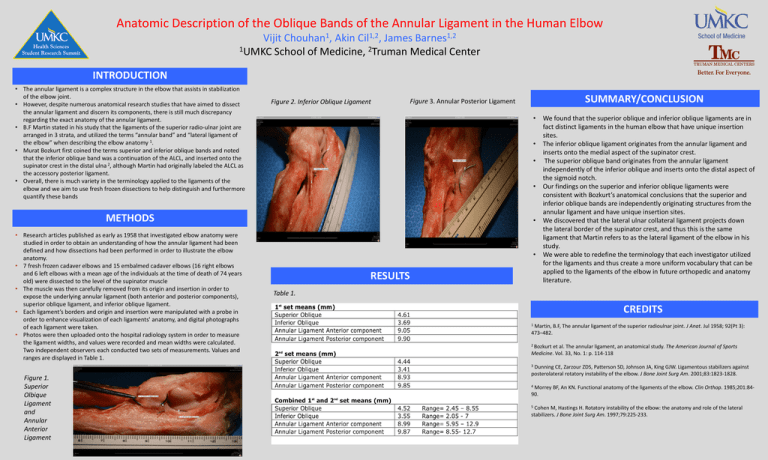Vijit Chouhan Ortho
advertisement

Anatomic Description of the Oblique Bands of the Annular Ligament in the Human Elbow Vijit Chouhan1, Akin Cil1,2, James Barnes1,2 1UMKC School of Medicine, 2Truman Medical Center INTRODUCTION • The annular ligament is a complex structure in the elbow that assists in stabilization of the elbow joint. • However, despite numerous anatomical research studies that have aimed to dissect the annular ligament and discern its components, there is still much discrepancy regarding the exact anatomy of the annular ligament. • B.F Martin stated in his study that the ligaments of the superior radio-ulnar joint are arranged in 3 strata, and utilized the terms “annular band” and “lateral ligament of the elbow” when describing the elbow anatomy 1. • Murat Bozkurt first coined the terms superior and inferior oblique bands and noted that the inferior oblique band was a continuation of the ALCL, and inserted onto the supinator crest in the distal ulna 2, although Martin had originally labeled the ALCL as the accessory posterior ligament. • Overall, there is much variety in the terminology applied to the ligaments of the elbow and we aim to use fresh frozen dissections to help distinguish and furthermore quantify these bands Figure 2. Inferior Oblique Ligament SUMMARY/CONCLUSION Figure 3. Annular Posterior Ligament • We found that the superior oblique and inferior oblique ligaments are in fact distinct ligaments in the human elbow that have unique insertion sites. • The inferior oblique ligament originates from the annular ligament and inserts onto the medial aspect of the supinator crest. • The superior oblique band originates from the annular ligament independently of the inferior oblique and inserts onto the distal aspect of the sigmoid notch. • Our findings on the superior and inferior oblique ligaments were consistent with Bozkurt’s anatomical conclusions that the superior and inferior oblique bands are independently originating structures from the annular ligament and have unique insertion sites. • We discovered that the lateral ulnar collateral ligament projects down the lateral border of the supinator crest, and thus this is the same ligament that Martin refers to as the lateral ligament of the elbow in his study. • We were able to redefine the terminology that each investigator utilized for the ligaments and thus create a more uniform vocabulary that can be applied to the ligaments of the elbow in future orthopedic and anatomy literature. METHODS • Research articles published as early as 1958 that investigated elbow anatomy were studied in order to obtain an understanding of how the annular ligament had been defined and how dissections had been performed in order to illustrate the elbow anatomy. • 7 fresh frozen cadaver elbows and 15 embalmed cadaver elbows (16 right elbows and 6 left elbows with a mean age of the individuals at the time of death of 74 years old) were dissected to the level of the supinator muscle • The muscle was then carefully removed from its origin and insertion in order to expose the underlying annular ligament (both anterior and posterior components), superior oblique ligament, and inferior oblique ligament. • Each ligament’s borders and origin and insertion were manipulated with a probe in order to enhance visualization of each ligaments' anatomy, and digital photographs of each ligament were taken. • Photos were then uploaded onto the hospital radiology system in order to measure the ligament widths, and values were recorded and mean widths were calculated. Two independent observers each conducted two sets of measurements. Values and ranges are displayed in Table 1. RESULTS Table 1. CREDITS 1 Martin, B.F, The annular ligament of the superior radioulnar joint. J Anat. Jul 1958; 92(Pt 3): 473–482. 2 Bozkurt et al. The annular ligament, an anatomical study. The American Journal of Sports Medicine. Vol. 33, No. 1: p. 114-118 3 Figure 1. Superior Olbique Ligament and Annular Anterior Ligament Dunning CE, Zarzour ZDS, Patterson SD, Johnson JA, King GJW. Ligamentous stabilizers against posterolateral rotatory instability of the elbow. J Bone Joint Surg Am. 2001;83:1823-1828. 4 Morrey BF, An KN. Functional anatomy of the ligaments of the elbow. Clin Orthop. 1985;201:8490. 5 Cohen M, Hastings H. Rotatory instability of the elbow: the anatomy and role of the lateral stabilizers. J Bone Joint Surg Am. 1997;79:225-233.







